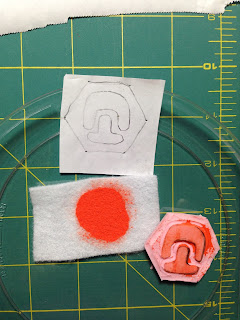In my day job, I've spent most of my career working on breast cancer research studies, and on the quilty side, right now, I'm slowly ( I do mean slowly) working on a wall-sized quilt that will be a surprise gift for a friend. The english-paper-pieced hexagon construction, which is appliqued onto a background, represents part of the sequence of the estrogen receptor (ESR1), an important protein in breast cancer biology. The sequence includes a mutation that my friend has spent many years working on. The mutation is known as K303R (303rd amino acid in the protein is changed from a lysine [K] to an arginine [R], which alters the function of the protein). For the more biologically savvy -- yes, I know that Deoxy-ribose (D in DNA) is a pentagon, not a hexagon. Too bad. This is art, or my version anyway. ;-)
 |
| DNA molecule appliqued onto background |
I pieced the DNA backbone and nucleic acids (light hexagons) and then carved stamps and printed the base pairs on each 'nucleotide pair' to represent the sequence. The whole gene is about 3000 base pairs, so obviously this is only a tiny fraction.
 |
| A-T stamp |
 |
| A-T and G-C stamps with test prints |
 |
| DNA after printing |
I have 'big stitched' some long swooping curves across the surface and am now starting to fill in the regions that the curves define with machine quilting.
 |
| Layered and 'Big Stitched' |
One of the first things I did was put 'ribbon candy' in between two closely spaced parallel sets of lines. I'm using Magnifico 40wt or KingTut 40wt in the needle and Aurifil 50wt in the bobbin. It was supposed to look a bit like a cell membrane. I'm really bad at ribbon candy, so it looks uneven and is disappointingly wimpy to boot.
 |
| Detail of double ribbon candy |
 |
| Detail of ribbon Candy |
I recently got to take a week long workshop at the John C Campbell Folk School with Lori Kennedy. Wow, what fun and what a great learning experience! I especially learned a lot about making the quilting a more visible part of the design. I needed a kick in the pants about this because I tend to second guess myself and am too timid. However, as Lori says, "when in doubt add more lines", so I went back and added another layer of quilting. I'm calling this design variation 'double ribbon candy'. I like the look -- it fills the space better and I think it is an improvement. For now, it is probably as good as it gets, given the busy-ness of the backgound fabric. I have lots more work to fill up the arest of the areas.
 |
| Doodled pattern |
I love the organic, biology-like pattern of the background fabric (its actually the 'wrong' side of a Kaffe Fassett Millefiori), but it is turning out to be a huge challenge getting any quilting to show, that I did not adequately consider at the start. I will probably live to regret the choice, but for now I'm forging ahead. My current mantra is 'if a little is good, more is better'.
Get out there and vote! Get your mammogram and thanks for reading -- comments are most welcome.
Susan
PS Other DNA quilts in the series cardiac DNA, cardiac DNA continued, and More DNA.
PPS This quilt is also pictured in AMSTAT News in the column about what statisticians do when they are not doing statistics.
Susan, your quilt is really cool. I love reading about the process and the science together. I laughed out loud when you explained that the "D" in DNA is a pentagon, not a hexagon! That was really bugging me...LOL!
ReplyDeleteI really don't mind that the quilting is subtle. When the viewer takes a closer look, they get the surprise of the interesting quilting.
What else do you have to do on this?
There are about 8-10 different regions defined by the large intersecting curves. Each needs to be filled in with 'something' with some repeats to give a sense of layering and continuity.
DeleteWow. Found your work by way of Inbox Jaunt. Love everything. Have learned at least 3 things I am going to try. Thank you.
ReplyDelete